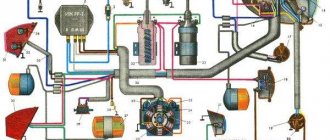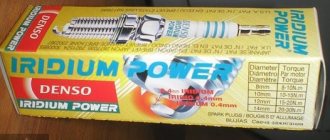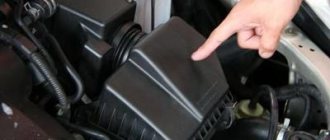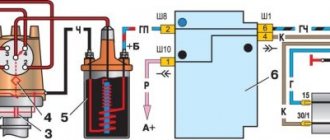The question often arises - after how long and how often do you need to change spark plugs? In general, among car owners and auto repairmen, there are different opinions about the timing of replacing a spark plug. And as you understand, there is no definite answer, everything is strictly individual.
Some spark plugs last for 10,000 km, others bring this figure to 100,000; you must agree, the range is great. But nevertheless, you need to try to understand the topic
and understand what determines the service life of this engine component.
After how long and how often you need to change spark plugs depends, first of all, on the spark plugs themselves, their quality, and manufacturer. In the auto parts market, spark plugs are divided into regular and platinum or iridium.
Due to their design features, spark plugs are located inside the engine and it is impossible to understand how bad the wear of an individual spark plug is without removing it. This imposes some difficulties, but nevertheless, there is an option to determine the service life of the spark plug - listen to the opinion of the car manufacturer, and you can find out the details in the car’s instructions.
Scheduled vehicle maintenance is usually carried out at 10,000-15,000 km, so it is recommended to change them every time you pass this mark. Since automakers assume that the car owner will use only original spark plugs in his car (these most often include the platinum or iridium type), then for regular spark plugs this figure should be reduced.
Alternatively, after a long run, for example, 15,000 km.
It is recommended to unscrew the spark plugs and check them for wear. But again, everything is individual and depends on many factors.
To one of the reasons
The reason why spark plugs quickly fail can be attributed to the use of a low-quality fuel mixture. Yes, it’s no secret that gas stations (especially those of unknown origin) operate in difficult competitive conditions and they physically cannot be competitive. This forces the use of multiple additives, resins, etc. which reduce the cost of obtaining fuel. And this negatively affects the performance of engines.
As you understand, there is only one piece of advice - refuel at stations that are represented by reputable fuel suppliers and always keep your receipt.
The first thing that catches your eye when the spark plugs are worn out is that the engine starts to stall. Extraneous, uncharacteristic vibrations and noises appear, and the speed is unstable. Before turning to specialists and spending your hard-earned money on it, you can try to visually assess the condition of the candles yourself.
Next you need to determine the electrode gap
, its size and soot level. To understand the size of the gap, you can read the instructions for the specific brand of spark plugs, there you will find the permissible values and values indicating that the spark plugs need to be replaced. A larger gap than necessary means the spark plug has traveled a sufficient number of km. mileage and requires replacement.
Regarding carbon deposits, ideally there should not be any, if it is present, then fuel combustion does not occur as it should. Also pay attention to the condition of the ceramic insulators. They must be intact, without any defects or cracks.
How often should spark plugs be changed? Assessing the condition of the spark plugs
Many people want to know about spark plugs and how often to change them.
This is very important, since the performance of the power unit and driving pleasure depend on it. Many experts and ordinary motorists have different opinions about the timing of replacing spark plugs, and this is not surprising. After all, not everyone reads the special documents that come with the car. The result is unpleasant situations. To prevent this, you should go to the manufacturer’s website and download the necessary documentation. It is worth noting that some spark plugs can last 10 thousand kilometers, while others can last 100 thousand. All this depends not only on the quality of workmanship, but also on service. After all, if the driver regularly cleans them and changes all special fluids, then there will be no problems. Spark plugs, how often to change them - this question worries many drivers. In addition, I would like to understand how to change spark plugs correctly, if necessary. It is worth noting that the process is not very difficult, anyone can do it. The main thing is to do everything carefully and slowly. The replacement period depends, first of all, on the manufacturer itself and the quality of the work. After all, if everything is done poorly, then the product will not last long. Currently, there are not only ordinary spark plugs, but also platinum and iridium spark plugs. All of them differ not only in cost, but also in service life.
Every driver knows that spark plugs are located directly in the car engine. To find out the wear of a part, it must be removed. There is no way without this. It is recommended to listen to the opinion of the car manufacturer and buy those spark plugs that suit your car. If you install others, some troubles will arise; this should always be remembered.
Everyone knows that maintenance is done every 10 thousand kilometers. In fact, this is a planned event that should not be missed. During its passage, you can change the spark plugs so that the power unit operates stably and without extraneous noise. Many manufacturers say the mark is slightly lower to warn drivers against possible unforeseen events. After all, it is not always possible to perform maintenance on time. It is recommended to change spark plugs after the 15 thousand kilometer mark. You should unscrew all the spark plugs and carefully inspect for wear.
The main reason for spark plug failure is the filling of low-quality fuel. Everyone knows that different fuels are currently sold that do not meet all standards. Because of this, serious problems arise with the power unit. It's no secret that there is serious competition in this area. Everyone wants to get more clients, and, accordingly, profit. We have to use all sorts of methods to dilute the fuel and so on. No one pays attention to quality, since the main thing is to sell. In modern fuel you can find not only additives, but also unpleasant impurities. This whole thing settles on the spark plugs, thereby worsening the work. Experts recommend refueling only at trusted gas stations where all the necessary documents are available. After refueling, be sure to keep your receipt.
When the spark plugs wear out, the engine begins to stall, operate unstably, and extraneous sounds and noises appear. All this negatively affects technical data and dynamics. The first step is to check the general condition of the spark plugs. Perhaps everything can be fixed on the spot, without contacting service.
After this procedure, the electrode gap, amount of carbon deposits and size are checked. As for the size itself, you can find out such information in the instructions that come with the brand of candles. If a large gap is detected, it means that the spark plugs have already traveled a sufficient number of kilometers and require replacement. If you close your eyes to this, then in the future the engine will no longer work correctly. As for soot, there shouldn’t be any at all. But if there is a small amount, then it’s okay. It is recommended to clean the spark plug and continue using it. If mechanical damage is detected, the spark plug is thrown out and a new one is installed. There's nothing you can do about it.
This is interesting: Selection of Kayaba shock absorbers by car
So we found out when to change spark plugs and how long they can last. When replacing, you should do everything according to the instructions, buy only those candles recommended by the manufacturer. Otherwise problems will arise. Spark plugs, how often should they be changed? This question comes up quite often. The answer to this can be found by reading the article. Every driver, even a novice, can change spark plugs. There is nothing complicated about this, the main thing is to do everything efficiently and accurately.
Reasons for their natural and premature wear
The spark plug operates under extremely extreme conditions:
- high temperature in the working cylinder;
- aggressive environment in the form of a mixture of fuel, air and oil;
- high pressure during ignition;
- high voltage and temperature of electric spark.
The simultaneous action of these factors leads to an intensification of the processes of their natural wear. This process can be significantly accelerated in the following cases:
- reduction of compression, wear of valve stem seals due to oil entering the working volume;
- incorrect setting of the ignition angle, leading to the formation of increased carbon deposits;
- choosing spark plugs that do not match the engine brand;
- misfire in cylinders;
- incorrect gasoline/air ratio due to malfunctions of the flow meter, lambda probe, or air leaks;
- incorrect operation of injectors.
Why change spark plugs if the old ones still work?
by wpadm May 21, 2016
It happens that you come to a car service center to change the engine oil, and in addition to this, the mechanic tells you:
“comrade, it’s time for you to change the spark plugs . And in response, your face stretches out in surprise, and you ask him in turn: “Why change the spark plugs if the old ones work?” .
Let's figure it out - it's time to throw away the old spark plugs or the car will still run just fine on them. To begin with, let's decide on the question - why does an engine need spark plugs , is it really possible without them? Let’s just say that without them the car simply won’t go anywhere, and if it does go, it will only be in a tow or tow truck, that is, not under its own power. According to the book, they are needed to use the spark that appears between the electrodes of the spark plug to ignite the fuel-air mixture in the engine cylinders. Moreover, each cylinder has its own spark plug.
In the future, you need to understand the design of any spark plug. So, a spark plug consists of:
- contact pin;
- insulator;
- insulator ribs;
- central electrode;
- side electrode;
- seal.
Each of these elements performs its own function: the high-voltage wire of the ignition system is connected to the contact terminal; the insulator protects the spark plug from overheating; the ribs of the insulator will not allow electrical breakdown along the surface of the insulator; the seal will not allow hot gases to escape from the combustion chamber; Well, it is between the central and side electrodes that the spark of interest to us arises.
So, depending on the gap between the central and side electrodes, ignition of the mixture will occur more or less effectively. The larger the gap, the more powerful the spark and the larger the ignition area, the combustion of fuel is more efficient; therefore, fuel consumption will be stable and engine operation will be smoother. If the gap in the spark plugs is small, then the spark will appear earlier, the spark energy will be less, the mixture will burn worse and the engine performance will deteriorate.
Gap on spark plugs VAZ 2114
One of the most important parameters in a spark plug is the gap between its contacts. This gap affects the formation of a spark at the contacts; the smaller the gap, the stronger and faster the spark; the larger, the weaker.
On VAZ 2114 engines, spark plugs must have a gap of 1 mm. This gap is optimal for proper and reliable operation of the engine.
What types of spark plugs are there?
Among themselves, car enthusiasts divide spark plugs into:
They are called so based on the materials used in the production of electrodes. In classic spark plugs, the electrodes are made of copper, in platinum spark plugs, from platinum, and in iridium spark plugs, they are made of a special iridium alloy. Some manufacturers have classic spark plugs with copper electrodes; for “better quality” they are coated with yttrium alloy, which increases the stability of the electrodes.
Platinum is highly resistant to corrosion and can withstand high temperatures well, which significantly increases their service life. Iridium spark plugs are similar in their characteristics to platinum spark plugs. Meanwhile, the longest service life is for spark plugs whose electrodes are made from a platinum-iridium alloy.
The best spark plugs for VAZ 2114
One of the most popular and best spark plugs for the VAZ 2114 are spark plugs from NGK. NGK No. 11 spark plugs ensure excellent engine performance at all speeds, as well as in all temperature conditions. These candles will be an excellent option in terms of price-quality ratio. The cost of these candles is around 1000 rubles per set.
Another spark plug from the domestic manufacturer AU17DVRM , these spark plugs have proven themselves well on the market, and besides, AvtoVAZ installs just such spark plugs on its cars from the factory. The cost of these candles is around 700 rubles per set.
What is the lifespan of spark plugs?
There is no clearly defined service life for this or that type of candle; manufacturers link this to many factors that objectively affect the service life. For example, this is the material from which the spark plug electrodes are made, operating conditions, such as climatic conditions, fuel quality and many other parameters.
For example, ordinary classic spark plugs will last no more than 50 thousand kilometers on average. Platinum and iridium - approximately 90 thousand kilometers (almost twice as much as classic ones). Naturally, these figures are approximate and are directly dependent on what kind of gasoline is poured into the gas tank and the technical condition of the engine. Therefore, car manufacturers advise replacing classic spark plugs at every second scheduled maintenance (first 30, then 60 thousand km). Platinum or iridium spark plugs will travel one and a half to two times longer.
HOW TO CHANGE PLUGS IN A CAR?
Changing spark plugs in a car is not difficult; any car owner can handle this operation on their own.
If you decide to replace them off the road, then let the engine cool. Otherwise, you can burn yourself and damage the thread when unscrewing, since the heated metal expands.
- Open the hood; if you have a protective cover, you need to unscrew it and remove it. The contacts are equipped with protective caps with high-voltage wires. They must be carefully removed, holding them by the caps, but under no circumstances pull on the wires. You can break the connections, and then you will have to change the wiring.
- Around the ceramics from the nest, it is necessary to remove all carbon deposits and debris that have accumulated here. Otherwise, all this dirt may end up in the engine cylinder.
- To remove the spark plugs, carefully unscrew them with a wrench. Having moved from the dead point, try to unscrew it. Do not rush, you can damage the threads of the socket or body. Try screwing it in again a little, and continue turning it out carefully.
- After unscrewing the old spark plug, clean the threads from dirt with a rag. Screw in the new one. When you feel that the thread is tight, make a quarter turn, but do not overtighten, otherwise you may ruin the thread of the cylinder, or the element itself.
- Place the high-voltage caps on the contacts, replace the casing, and close the hood.
Replacing spark plugs with 8kL
For the first two or three days, observe how your new thing works. It is possible that a defect may occur, then the engine will operate intermittently. If this happens, you can determine which spark plug is defective by sequentially disconnecting the wires. Be sure to replace the rejected part.
If you don't change the spark plugs in time
Let’s say we missed day “X” of replacing the spark plugs, or forgot about it altogether. On one of the ordinary days, when the boss yells into the phone that you overslept and you jump behind the wheel in one trouser leg to start the car, trying to teleport to work as quickly as possible, the car will show you the fig, it simply won’t start.
Therefore, we advise you to pay close attention to signs indicating that your spark plugs are about to fail. To avoid falling into such an ambush, it is better to set yourself a reminder in advance about the upcoming event and from time to time listen to the sound of the engine. What to pay attention to:
- the engine begins to “trouble” - twitching while driving or idling;
- the engine starts with difficulty - the starter turns the engine, but there is no ignition;
- you will notice that more fuel is being consumed;
- CO emissions will increase;
- the engine dynamics have deteriorated significantly; the engine does not produce the maximum number of revolutions and, of course, the engine power decreases.
If the symptoms described above are ignored, the engine may fail. What can we deduce from all this? So:
- Install only spark plugs recommended by the manufacturer into the engine;
- Despite the seemingly stable operation of the ignition, check the condition of the spark plugs at each scheduled maintenance;
- Long-term operation (mileage of 50 thousand kilometers or more) is possible when installing spark plugs with platinum or iridium electrodes;
- To extend the service life of spark plugs, fill only with high-quality fuel, change filters on time, and ensure correct spark plug gaps;
- If signs of faulty spark plugs do appear - the engine is shaking, fuel consumption has increased, the speed has started to fluctuate, immediately contact a service station or replace the spark plugs yourself, it’s not difficult.
Let's sum it up
You need to change spark plugs according to the instructions of the company that released your car. This frequency must be adhered to, but no one is immune from force majeure circumstances. For example, if the fuel supply system becomes clogged, the spark plugs begin to work in the wrong conditions, so their service life is significantly reduced.
Also, if chips and cracks of the insulator are visible on the spark plugs, then under no circumstances should they be inserted back. A clear sign of replacement is also considered to be melting of the electrodes and large carbon deposits.
Better keep an eye on all the components of the car, in this case there will be no problems in the operation of the internal combustion engine and the spark plugs will be able to last for a very long time. In conclusion, I would like to say that you should not save money on servicing your car. Let's say you save on fuel, but in a few years this may result in a major overhaul of the engine.
Now you know everything about replacing spark plugs, how to do it correctly, and what you should pay attention to. All you have to do is go to the store and start replacing, we wish you success!
| SHARE: |
How long do spark plugs last on a car and how often do you change them?
Let's try to figure out how often you have to change spark plugs in a car, what causes their failure.
Short. Just in case!
Spark plugs in an internal combustion engine are the key to starting the combustion process of the air-fuel mixture in the cylinders of a car’s power unit. Misfire of even one of them significantly reduces the power of the power plant. The emission of harmful gases into the atmosphere is increasing. The malfunction problem may be due to a manufacturing defect or late replacement.
Why change working spark plugs?
If well cared for, power supplies can last over 10 years, but all items have an expiration date on them that must be taken into account. Old devices, even if they do not show wear, can lead to damage to motor parts. Should be considered:
- Changing the gap between the electrodes negatively affects the ignition timing.
- Misfire leads to detonation and wear of engine parts.
- Dirty spark plugs can damage the ignition coil.
- Incorrectly functioning elements affect the environmental parameters of the power unit.
The worst problem that can arise with old CBs is contamination of the threaded connection, which can result in thread failure, which will entail the need to replace the BC.
How often should you change spark plugs?
First of all, let's “separate the flies from the cutlets” and remember that candles are divided:
Practice shows:
- Simple ones can be replaced after 20-30 thousand kilometers.
- Platinum ones will last you from 50 to 60 thousand kilometers. There is a possibility of insulator failure. Electrical breakdowns occur as shown in the previous photo.
- Iridium tests are carried out after the car has covered 100,000 km.
This is interesting: How not to buy junk cars: important tips
There are situations when the electrodes of car spark plugs burn out. Poor quality fuel has a negative impact. The car loses power. Or vice versa, the driver saves and manages to last 80 thousand km using simple spark plugs. Not realizing that with a loss of power in this case, excessive fuel consumption is inevitable.
Signs of malfunction, what to look for
The power unit on the car is troit. The engine jerks. When removing the spark plug, carbon deposits and the gap size exceed or fall below that recommended by the manufacturer. The information (last digit) is provided directly on it and indicates the gap in mm. When the gap increases, it needs to be replaced. When answering the question, how often should you change spark plugs , pay attention to the condition and color. More precisely, on a ceramic insulator. It may be covered with a web of tiny cracks filled with a brown coating.
When the metal body and ceramic insulator delaminate, a dark brown “skirt” appears on the products. The defect is obvious. It is advisable to replace the entire set. However, when passing the recommended mileage, you also need to change the entire set, and not just one or two spark plugs.
How do you know when it's time to change the spark plugs?
The frequency of replacing spark plugs depends not only on the mileage of the vehicle, but also on the condition of the spark plugs. There are many signs indicating possible faulty spark plugs:
- Strong smell of gasoline from the catalytic converter (indicates that the fuel is not burning completely).
- Increased fuel consumption (due to misfire).
- Difficulty starting the car engine.
- Unstable engine operation (spinning, stalling, low speed, reduced power, jerking) Sometimes detonation and other external sounds are clearly audible.
- Change in the nature of the exhaust gases (soot appears, an odor appears, the analyzer shows an increased CO level).
- Visual defects of spark plugs (cracks, nicks, melting, uneven color of electrodes, carbon deposits).
- The CHECK ENGINE warning light on the instrument panel comes on.
If your vehicle exhibits any of the above symptoms, it is recommended that you have your spark plugs checked.
If it's just a blockage, it can be cleaned and the spark plugs can be extinguished a little. If your spark plug has oil on it or has a strange residue on it, it might make sense to change the oil grade and start filling in a different location. If the spark plug shows visible signs of damage, replace it immediately!
Where to buy quality goods?
“hot” product , which is used by unscrupulous businessmen. Counterfeit brands are offered everywhere. There is no need to talk about the quality of such a product. Car markets and some small shops on highways and city outskirts are considered a hot spot. Passing motorists buy the product, replace it, and after a short mileage are forced to repeat the replacement operation. This is usually already far from the place of purchase. Therefore, you should purchase goods from time-tested suppliers with an unblemished business reputation. Where can they give a quality guarantee?
In custody
I would like to remind you that, paradoxical as it may sound, you yourself should know the answer to the question of how often and when you need to change the spark plugs on your car. After all, you are its owner and, in most cases, the driver. Listen to the operation of the power unit and look at the speedometer. There is no need for a nanny in this matter!
We also advise you to read:
How to replace the filter on Peugeot 308 and 408 yourself
Electronic car systems - to help the driver
Recommendations for extending the life of products
To extend the service life you just need:
- It is necessary to refuel with high-quality fuel, and therefore you should not use the services of dubious gas stations, regardless of the cost of fuel.
- Constantly monitor the oil level in the vehicle unit.
- Purchase original products according to the individual characteristics of the car.
- Regularly clean the device from carbon deposits and other contaminants.
- Pass technical inspections in a timely manner and monitor the operation of all vehicle mechanisms.
Remember that timely replacement of spark plugs will guarantee reliable operation of the machine’s power plant and protect against unpleasant surprises. Only high-quality factory spark plugs will give the car enthusiast an easy running of the car and will increase the service life of these products several times.
How long does it take to change spark plugs?
For stable and trouble-free operation of the car, it is necessary to frequently carry out timely maintenance, including high-voltage spark plugs. The frequency of checking clearances is determined by the car manufacturer.
On average, if there are no malfunctions and the operating rules are followed, spark plugs should be replaced every 25–30 thousand km.
In cars that use gas as the main fuel, the replacement period is reduced by 25–35%. Spark plug gaps must be checked every 6 thousand kilometers.
The World Matizov channel presents the frequency of replacement of spark plugs for gasoline cars.
Characteristic signs of faulty spark plugs
Signs of faulty spark plugs are:
- unstable operation of the engine, the engine troits and is difficult to start;
- the power of the unit has dropped significantly;
- the consumption of the fuel-air mixture has increased;
- the color of the exhaust gases has changed;
- failure of the cylinder-piston group.
Reasons for the formation of black soot
Black carbon deposits on spark plugs appear due to a malfunction of the engine or ignition system.
The reason for this process may be:
- The thermal clearances of the valve mechanism are set incorrectly or the valve in the motor head is burnt out. Carbon deposits form on one side of the electrode.
- Incorrect candle selected. The potassium number depends on the heating of the engine. The higher this indicator, the higher the engine temperature. With a low value, the spark plug burns out on the electrode cone.
- If the spark plug is completely blackened, the cause is a rich fuel mixture.
- Light carbon deposits indicate a clogged air filter.
- Black glow occurs when the ignition angle is incorrect.
These problems can be diagnosed by the condition of the ignition elements.
Why is it so important to observe replacement intervals?
If the car owner is overdue for replacing the spark plugs, this will not immediately lead to serious malfunctions. But a situation may occur when the car will not start. To avoid such a problem, it is important to observe the frequency of changing elements.
Factors that shorten spark plug life
There are a number of factors affecting the operation of power supplies:
- Fuel-air mixture. A lean mixture contributes to early ignition and fuel detonation, which leads to mechanical damage to the engine. A rich mixture provokes the appearance of black carbon deposits on the electrodes of the spark plug and further failure of the part.
- Compression. High or low compression in the cylinders creates temperature differences in the combustion chamber, as a result of which the cylinders operate unstably and burn out over time.
- Incorrectly set ignition affects the duration of operation of the elements.
- Too low a temperature causes the air-fuel mixture to become lean.
- Air humidity reduces the compression of the power unit.
Therefore, it is necessary to periodically diagnose the engine and ignition system.
How to check spark plugs
You can understand that it’s time to change the ignition elements not only by the behavior of the car in motion, but also with the help of devices such as a multimeter and a gun.
Diagnostics with a multimeter
This device checks for breakdown of the central electrode of the spark plug. You need to turn on the ohmmeter mode. One wire is connected to the spark plug output, and the other to the thread. If the value on the dial is less than 100 Ohms, then the element is broken and requires replacement. This method is indirect, since the candle is checked only for breakdown.
Candle gun
To check the condition, insert the candle into the groove and put on a leash. By pressing the trigger of the gun, a spark should appear and the signal light should light up; if everything corresponds, the element is working. When the spark plug does not work in the appropriate manner, it must be replaced. You need to replace the ignition elements as a set.
The main malfunctions of spark plugs and their causes
| Malfunctions | Causes |
| – burnout/melting of contacts (increased gap) | Natural wear, poor quality spark plugs (contact material) |
| – coking, coating with various types of deposits | Poor quality gasoline, malfunction of the gas distribution system, wear of the piston group, malfunction of the ignition system |
| - ground test | Natural wear and tear, poor quality spark plugs |
Bad spark plugs are often activated on the “Check Engine” panel due to misfires, but the absence of errors does not guarantee absolute serviceability. Therefore, it will not be possible to unambiguously diagnose the problem without removing the spark plugs, and sometimes special devices will be required:
Procedure for replacing spark plugs
When the deadline has come or a technical malfunction has occurred with the spark plugs, we change the elements as follows:
- The hood opens, the battery and high-voltage wires on the spark plugs are disconnected. It is necessary to remember and mark the locations of the conductors along the cylinders. On some cars with a 16-valve engine, access to the spark plugs is blocked by the manifold. It must be removed before replacing the ignition elements.
- Places where spark plugs are installed are cleaned of dust and dirt using a metal brush. Next, you need to thoroughly blow air over the parts so that debris does not get into the cylinder.
- The old spark plugs are removed using a 18 or 21 wrench head and their technical condition is inspected.
- If there is no black carbon deposits, then you can safely install new spark plugs. Before installation, you need to check the gap between the electrodes, it should be the same. The gap parameter is individual for each car, but on average it is 0.75-1.2 mm.
- The candles are being drawn. When tightening, do not use long levers so as not to strip the threads in the engine.
- The armored wires are being connected.
- The terminal is put on the battery and the engine starts. The engine should start smoothly.
- You need to drive 1 kilometer and inspect the spark plugs for carbon deposits.
Precautions when replacing spark plugs
When replacing spark plugs in a car, work must be done with a cool engine to avoid burns. You need to wait two to three hours until the engine cools down.
WHAT TO DO IF IT'S FLOODED?
Every car owner should know what to do when the spark plugs are flooded. Most often, motorists encounter this problem when operating a vehicle in the cold season. In such cases, purging the motor will help. To do this you need to have with you:
- Candle key. Let me dwell on this in more detail. There are many of them in retail chains; any customer request can be satisfied. You can choose the simplest tubular one, the price of which is a little over 80 rubles. Or buy expensive keys with cardan shafts, at a price of 300 rubles apiece. Good reviews are received by such models as a key with a T-shaped handle FIT 63745, keys with cardan models FIT 63747, VIRA 511045, or this one.AIRLINE AK-S-01;
- Spark plugs, preferably new ones;
- Charged battery.
Candle keys
Next steps will be as follows:
- Remove the protective casing on the engine (if equipped);
- Disconnect high-voltage wires from ignition devices;
- Turn them out of the cylinder head;
- Disconnect the wires from the ignition unit;
- Press the gas pedal to the limit and crank the engine with the starter for about 7-10 seconds;
- Now you can put the candles;
- Connect high voltage wires. Each wire fits a specific spark plug, try not to confuse them;
- The connector from the ignition unit is put in place.
Now you can try to start the engine. Some drivers warm up “flooded spark plugs” using accessible methods.











